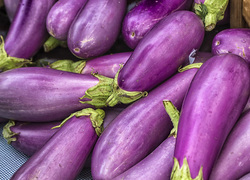5 Tips for Growing Easy Fruit & Vegetables

Growing veggies can be easy.
Growing easy fruit & vegetables can provide you with deliciously fresh produce, save you money, and keep your work to a minimum. You don't have to dig up half of your yard to grow veggies. Use one or all of these tips to make growing food easy.
1. Plant fruit & vegetables in pots or windowboxes - If you have a window or space for a pot, you have room to grow fruit & veggies. Grab a couple of good size pots or boxes and get planting. Some experts recommend buying a bag of "soilless" potting mix, but compost or healthy dirt can work too. To make watering easier (less frequent): use self-watering pots that hold water in a special reservoir, group pots close together (so they don't dry out as quickly), or use bigger pots that stay moist longer.
When choosing fruits & vegetables to grow in pots or windowboxes, look for smaller varieties or "bush" varieties that don't get as big. Good vegetables to grow in pots include potatoes, chard, lettuce, cherry and bush tomatoes, peppers, eggplants, summer squash, pole beans, and herbs too. Fruits to grow include strawberries, blueberries, and dwarf fruit trees (apple, pear, peach, plum, etc.). But don't feel limited to these lists.
2. Mix fruit & vegetables in with your flower beds - Why dig up another area just for fruits & vegetables? Grow them mixed in with your flowers and shrubs to save yourself extra work. They will also benefit from helpful bugs that are attracted to the flowers, and then eat pests that would normally attack your crops. Lettuces, greens, and herbs look great in a flower bed. See what combination works well for you.
3. Plant perennial vegetables & fruit that come back each year - One of the hardest parts about growing a garden is replanting each year. Take replanting out of the equation, and you save yourself a lot of work (and money). Most fruits come back each year so go plant some strawberries, raspberries, blackberries, blueberries, fruit trees, and whatever else you enjoy eating. Perennial vegetables include asparagus, rhubarb, Jerusalem artichokes, ramps (wild leeks), sea kale, lovage, sorrel, and others. Don't forget herbs like thyme, sage, cilantro, dill, and oregano that will come back each year.
4. Plant a square foot garden - A square foot garden is designed to make your garden easy and organized. Create a space that is usually 3-4 feet wide by 6-8 feet long. You can make it smaller or longer, but it may be hard to reach the middle if it is wider than 3-4 feet (unless you have crazy long arms). In each square foot, pick a different vegetable to plant. One tomato may go in one square foot, while several onions could be planted in another, and a couple lettuce plants in another. Some use raised gardens for this method, which can save you from digging. Spacing for plants tends to be closer than what is recommended on a package. You can find more information on square foot gardening here.
5. Seeds + Water + Jar = Sprouts grown in your kitchen - Want to keep dirt off of your hands or avoid going outside? You can still grow vegetables. Buy some seeds, soak them in a jar, rinse them off, repeat for a couple days, and you have some fresh sprouts. Seeds commonly used for this include alfalfa, broccoli, radish, and mung beans among others. They can be used for salads, sandwiches, or anything else you can come up with. Learn more about sprouting seeds here.
Our bodies need a good dose a fruits & vegetables every day to be their healthiest. The easiest (and least expensive way) to get them is by growing some yourself. Try one of these tips for growing easy fruits & vegetables.
1. Plant fruit & vegetables in pots or windowboxes - If you have a window or space for a pot, you have room to grow fruit & veggies. Grab a couple of good size pots or boxes and get planting. Some experts recommend buying a bag of "soilless" potting mix, but compost or healthy dirt can work too. To make watering easier (less frequent): use self-watering pots that hold water in a special reservoir, group pots close together (so they don't dry out as quickly), or use bigger pots that stay moist longer.
When choosing fruits & vegetables to grow in pots or windowboxes, look for smaller varieties or "bush" varieties that don't get as big. Good vegetables to grow in pots include potatoes, chard, lettuce, cherry and bush tomatoes, peppers, eggplants, summer squash, pole beans, and herbs too. Fruits to grow include strawberries, blueberries, and dwarf fruit trees (apple, pear, peach, plum, etc.). But don't feel limited to these lists.
2. Mix fruit & vegetables in with your flower beds - Why dig up another area just for fruits & vegetables? Grow them mixed in with your flowers and shrubs to save yourself extra work. They will also benefit from helpful bugs that are attracted to the flowers, and then eat pests that would normally attack your crops. Lettuces, greens, and herbs look great in a flower bed. See what combination works well for you.
3. Plant perennial vegetables & fruit that come back each year - One of the hardest parts about growing a garden is replanting each year. Take replanting out of the equation, and you save yourself a lot of work (and money). Most fruits come back each year so go plant some strawberries, raspberries, blackberries, blueberries, fruit trees, and whatever else you enjoy eating. Perennial vegetables include asparagus, rhubarb, Jerusalem artichokes, ramps (wild leeks), sea kale, lovage, sorrel, and others. Don't forget herbs like thyme, sage, cilantro, dill, and oregano that will come back each year.
4. Plant a square foot garden - A square foot garden is designed to make your garden easy and organized. Create a space that is usually 3-4 feet wide by 6-8 feet long. You can make it smaller or longer, but it may be hard to reach the middle if it is wider than 3-4 feet (unless you have crazy long arms). In each square foot, pick a different vegetable to plant. One tomato may go in one square foot, while several onions could be planted in another, and a couple lettuce plants in another. Some use raised gardens for this method, which can save you from digging. Spacing for plants tends to be closer than what is recommended on a package. You can find more information on square foot gardening here.
5. Seeds + Water + Jar = Sprouts grown in your kitchen - Want to keep dirt off of your hands or avoid going outside? You can still grow vegetables. Buy some seeds, soak them in a jar, rinse them off, repeat for a couple days, and you have some fresh sprouts. Seeds commonly used for this include alfalfa, broccoli, radish, and mung beans among others. They can be used for salads, sandwiches, or anything else you can come up with. Learn more about sprouting seeds here.
Our bodies need a good dose a fruits & vegetables every day to be their healthiest. The easiest (and least expensive way) to get them is by growing some yourself. Try one of these tips for growing easy fruits & vegetables.



